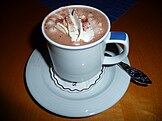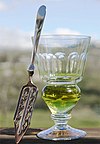The Drink Portal
A portal dedicated to all beverages
Introduction

A drink or beverage is a liquid intended for human consumption. In addition to their basic function of satisfying thirst, drinks play important roles in human culture. Common types of drinks include plain drinking water, milk, juice, smoothies and soft drinks. Traditionally warm beverages include coffee, tea, and hot chocolate. Caffeinated drinks that contain the stimulant caffeine have a long history.
In addition, alcoholic drinks such as wine, beer, and liquor, which contain the drug ethanol, have been part of human culture for more than 8,000 years. Non-alcoholic drinks often signify drinks that would normally contain alcohol, such as beer, wine and cocktails, but are made with a sufficiently low concentration of alcohol by volume. The category includes drinks that have undergone an alcohol removal process such as non-alcoholic beers and de-alcoholized wines. (Full article...)
Selected article -
The first chocolate drink is believed to have been created at least 5,300 years starting with the Mayo-Chinchipe culture in what is present-day Ecuador and later consumed by the Maya around 2,500–3,000 years ago. A cocoa drink was an essential part of Aztec culture by 1400 AD, by which they referred to as xocōlātl. The drink became popular in Europe after being introduced from Mexico in the New World and has undergone multiple changes since then. Until the 19th century, hot chocolate was used medicinally to treat ailments such as liver and stomach diseases.
Hot chocolate is consumed throughout the world and comes in multiple variations, including the spiced chocolate para mesa of Latin America, the very thick cioccolata calda served in Italy and chocolate a la taza served in Spain, and the thinner hot cocoa consumed in the United States. Prepared hot chocolate can be purchased from a range of establishments, including cafeterias, fast food restaurants, coffeehouses and teahouses. Powdered hot chocolate mixes, which can be added to boiling water or hot milk to make the drink at home, are sold at grocery stores and online. (Full article...)
Did you know? -
- ... that Phil Elverum recorded Don't Wake Me Up nocturnally, while "drinking pots of black tea all night"?
- ... that Assyrian Christian couples drink dust from the tombs of martyrs and are crowned during their weddings?
- ... that Maxine North swore never to return to Thailand after the death of her undercover CIA husband, but ultimately settled there and introduced bottled water to the country?
- ... that the relatively low standards of player selection for Somerset County Cricket Club in 1883 have been described as being "determined with a nod and a wink over drinks"?
- ... that the "Mayor of Picklesburgh" is decided by a pickle juice drinking competition?
- ... that the John Snow pub is named for a shy British epidemiologist who did not drink?
General images -
Selected image -

Selected biography -
Frederick Edward John Miller (November 24, 1824 – May 11, 1888) was a brewery owner in Milwaukee, Wisconsin. Born as Friedrich Eduard Johannes Müller in Riedlingen, Württemberg, he founded the Miller Brewing Company at the Plank Road Brewery, purchased in 1855. He learned the brewing business in Germany at Sigmaringen.
Miller married Josephine Miller in Friedrichshafen, Württemberg, on June 7, 1853. Their first child, Joseph Edward Miller, was born the next year. In 1854, the family emigrated to the United States, spending the first year in New York. They moved to Wisconsin in 1855, arriving through New Orleans. (Full article...)Selected quote -
| “ | And malt does more than Milton can To justify God's ways to man. |
” |
| — A. E. Housman A Shropshire Lad LXII. |
Selected ingredient -
Many varieties of rice have been bred to improve crop quality and productivity. Biotechnology has created Green Revolution rice able to produce high yields when supplied with nitrogen fertilizer and managed intensively. Other products are rice able to express human proteins for medicinal use; flood-tolerant or deepwater rice; and drought-tolerant and salt-tolerant varieties. Rice is used as a model organism in biology.
Dry rice grain is milled to remove the outer layers; depending on how much is removed, products range from brown rice to rice with germ and white rice. Some is parboiled to make it easy to cook. Rice contains no gluten; it provides protein but not all the essential amino acids needed for good health. Rice of different types is eaten around the world. Long-grain rice tends to stay intact on cooking; medium-grain rice is stickier, and is used for sweet dishes, and in Italy for risotto; and sticky short-grain rice is used in Japanese sushi as it keeps its shape when cooked. White rice when cooked contains 29% carbohydrate and 2% protein, with some manganese. Golden rice is a variety produced by genetic engineering to contain vitamin A. (Full article...)Topics
| General topics: | Bartending • Bottling • Drinking • Drinking water • Bottled water • Mineral water • Coffee • Energy drink • Juice • Tea • Milk • Plant milk • Pasteurization • Refrigeration • Steeping • Water purification |
| Alcoholic beverages: | Beer • Brandy • Brewing • Caffeinated alcoholic drinks • Cider • Cocktails • Distillation • Fermentation • Hard soda • Liquor • Liqueur • Malt drink • Mead • Proof • Rice Wine • Schnapps • Vodka • Whiskey • Wine |
| Soft Drinks: | Carbonation • Cola • Orange soft drink • Frozen carbonated drink • Root beer • Soda water • Lithia water • |
| Miscellaneous: | Drink industry • Lemonade • Limeade • Orange drink • Slush (beverage) |
List articles
Subcategories
Related portals
WikiProjects


WikiProject Food & Drink is an association of Wikipedians with an interest in culinary-related subjects. They have come together to co-ordinate the development of food and drink articles here on Wikipedia as well as the many subjects related to food such as foodservice, catering and restaurants. If you wish to learn more about these subjects as well as get involved, please visit the project.
 WikiProject Beer – covers Wikipedia's coverage of beer and breweries and microbreweries
WikiProject Beer – covers Wikipedia's coverage of beer and breweries and microbreweries
![]() WikiProject Wine – aims to compile thorough and accurate information on different vineyards, wineries and varieties of wines, including but not limited to their qualities, origins, and uses.
WikiProject Wine – aims to compile thorough and accurate information on different vineyards, wineries and varieties of wines, including but not limited to their qualities, origins, and uses.
| Child projects: | Task forces: (All inactive) |
| Related projects: | |
Things you can do
 |
Here are some tasks awaiting attention:
|
Associated Wikimedia
The following Wikimedia Foundation sister projects provide more on this subject:
-
 Commons
Commons
Free media repository -
 Wikibooks
Wikibooks
Free textbooks and manuals -
 Wikidata
Wikidata
Free knowledge base -
 Wikinews
Wikinews
Free-content news -
 Wikiquote
Wikiquote
Collection of quotations -
 Wikisource
Wikisource
Free-content library -
 Wikiversity
Wikiversity
Free learning tools -
 Wiktionary
Wiktionary
Dictionary and thesaurus
More portals
Purge server cache
































































Recent Comments